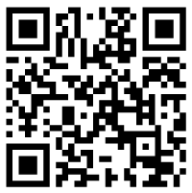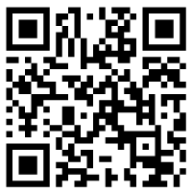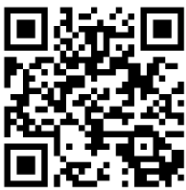Αυτό το πρόγραμμα είναι διαθέσιμο μόνο στην αγγλική γλώσσα.
The Centre for Lifelong Learning of the Cyprus University of Technology, in collaboration with the Department of Multimedia and Graphic Arts, is organizing a continuing professional education program titled:
''Audio programming and Interaction''
The training program is structured into three levels. Below, you can find information and register for each level separately.
Program Staff
Scientific Director/ Instructor: Dr. Marinos Koutsomichalis
Dr Marinos Koutsomichalis is a Lecturer in Creative Multimedia where he co-directs the Media Arts and Design Research Lab. He has a PhD in Electronic Music and New Media (De Montfort University, UK) and a MA in Music Composition with Digital Media (University of York, UK). He has held research positions at the Department of Computer Science of the Norwegian University for Science and Technology (Trondheim, NO) and at the Interdepartmental Center for Multimedia Research of the University of Turin (IT). He has lectured at the University of Wolverhampton (Birmingham, UK) and at the Technological Educational Institute of Crete (Rethymnon, GR).
More information here
Level 1: Introduction to programming for audio and computer music (Offering period: March – April 2026)
Program Overview
This course offers a first introduction to the world of algorithmic audio, digital sound synthesis, and computer music. It teaches the fundamentals of digital audio and programming for audio applications using the SuperCollider programming environment and reviews some of the most standard techniques for sound synthesis and algorithmic music. The course is the foundation for the more advanced “Advanced programming for audio and computer music” and “Design music interfaces & instruments” courses facilitated by the same instructor. No prior programming or other special background is needed, so that the course also works as an informal introduction to computer programming, and digital signal processing.
Audio programming is a topical field of study with application across various disciplines and the industry; it is relevant to: application development, music, instrument design, multimedia design, sound design for cinema/theater, game audio, UX/UI, and many more. Training in this field is a crucial skill for many professionals, creative individuals, and digital arts/culture enthusiasts. This course empowers professionals and enthusiasts to creatively manipulate sound through advanced technological tools, enabling them to invent novel musical instruments, realise own compositions, generate content, and produce new products/services (or enhance existent ones).
Target Audience
Α. Musicians/artists wishing to expand their skills in audio programming and computer music.
B. Technologists and programmers wishing to expand their skills in sound.
C. Unemployed individuals wishing to acquire a foundation so as to further study topics related to audio and instrument design.
D. Electronic music / creative multimedia enthusiasts wishing to acquire some hands-on knowledge on the subject so as to better appreciate it.
Course Modules
There are 2 Modules:
- Digital Audio Fundamentals (16 hours, 4 weeks)
Students are theoretically introduced to the fundamentals of digital audio as well as to important topics in acoustics, psychoacoustics, electromechanical signals and systems and frequency domain representation.
- Programming Audio with SuperCollider (24 hours, 6 weeks)
Building upon module 1 and following a scaffolding hands-on approach, students are introduced into programming own real-time audio applications with the SuperCollider language.
Learning Outcomes – Competencies Acquired Upon Completion
Knowledge-Based Outcomes
Having completed the course, trainees will be able to:
- Identify and think about contemporary affairs in audio synthesis, audio programming, and algorithmic music.
- Describe a number of techniques with respect to audio synthesis
- Identify and describe fundamental aspects of computer programming, digital audio, and interaction design
- Identify techniques with respect to computer music.
Skills-Based Outcomes
Having completed the course, trainees will be able to:
- Implement a number of techniques in the fields of audio programming, sound synthesis, and computer music
- Produce electronic/electroacoustic/computer music studies
- Compose sound effects for use in cinema, theater, video games, etc
Competency-Based Outcomes
Having completed the course, trainees will be able to:
- A deeper appreciation for algorithmic music and sound synthesis
- A better understanding of digital audio and, thus, contemporary multimedia culture
- An aesthetic sensitivity towards sound effects and electronic musics of all sorts
Dates & Participation
- Period: March - April 2026
- Exact dates and times will be announced after expressions of interest.
- Duration: 40 Hours
- Mode: Distance e-Learning – Asynchronous Instruction and Live Q&A
- Certificate: Certificate of Attendance
- Cost: €400
Expression of Interest:
Please express your interest here: https://forms.office.com/e/jicpPijJv4

Contact Information
lifelong.learning@cut.ac.cy
+357 25002945
Level 2: Advanced programming for audio and computer music (Offering period: May – June 2026)
Program Overview
This course is a deep dive in the world of algorithmic audio, digital sound synthesis, computer music, and the design of related software. It assumes familiarity with the fundamentals of digital audio and programming for audio applications (and thus, builds on top of the “Introduction to programming for audio and computer music” class also facilitated by the same instructor). It comprises two individual modules. The first is concerned with advanced sound synthesis and algorithmic music techniques employing the SuperCollider programming environment. These involve granular synthesis, scientific data signification, bio-inspired algorithms, machine listening, and more. The second module is concerned with real-time audio synthesis employing C++ and in the context of designing plug-in or stand-alone audio software. Some programming experience (e.g. with SuperCollider or Python) and some understanding of digital audio and sound synthesis is necessary so as to attend the course; individuals not having such a background are encouraged to finish the “Introduction to programming for audio and computer music” first.
Audio programming is a topical field of study with application across various disciplines and the industry; it is relevant to: application development, music, instrument design, multimedia design, sound design for cinema/theater, game audio, UX/UI, and many more. Training in this field is a crucial skill for many professionals, creative individuals, and digital arts/culture enthusiasts. This course empowers professionals and enthusiasts to creatively manipulate sound through advanced technological tools, enabling them to invent novel software-based musical instruments, realise own compositions, generate content, and produce new products/services (or enhance existent ones).
Target Audience
Α. Professional musicians/artists wishing to expand their skills in digital audio
B. Professional technologists, programmers, designers wishing to expand their skills in sound
C. Unemployed individuals wishing to start a career in designing developing their own instruments or software or composing music and sound effects
D. Electronic music / creative multimedia enthusiasts wishing to acquire some hands-on knowledge on the subject so as to better appreciate it.
Course Modules
There are 2 Modules:
- Advanced Algorithmic Sound Synthesis (20 hours, 5 weeks)
Following a scaffolding hands-on approach, and building upon the material covered in the “Introduction to programming for audio and computer music” students are guided into sophisticated algorithmic sound synthesis techniques.
- Real-time Audio Synthesis with C++ (24 hours, 6 weeks)
Having some concrete experience in digital audio with SuperCollider, students are introduced into applying the same techniques employing C++ developing programs that can be readily deployed as standalones or plug-ins in all major operating systems (Android, iOS, Linux, Windows, MacOS, etc).
Learning Outcomes – Competencies Acquired Upon Completion
Knowledge-Based Outcomes
Having completed the course, trainees will be able to:
- Identify and think about contemporary affairs in audio synthesis, audio programming, and algorithmic music.
- Describe a number of advanced techniques with respect to audio synthesis
- Identify and describe aspects of computer programming, digital audio, and interaction design
- Identify advanced techniques with respect to algorithmic music
Skills-Based Outcomes
Having completed the course, trainees will be able to:
- Implement a number of techniques in the fields of audio programming, sound synthesis, and computer music employing SuperCollider and C++
- Produce original compositions of electronic/electroacoustic music
- Compose sound effects for use in cinema, theater, video games, etc
- Develop software applications pivoting on digital audio
- Design novel virtual instruments and new products/services with respect to digital audio
Competency-Based Outcomes
Having completed the course, trainees will be able to:
- A deeper appreciation for algorithmic music and sound synthesis
- A better understanding of digital audio and, thus, contemporary multimedia culture
- The ability to debate on topical affairs with respect to audio programming and instrument design
- An aesthetic sensitivity towards sound effects and electronic musics of all sorts
Dates & Participation
- Period: May – June 2026
- Exact dates and times will be announced after expressions of interest.
- Duration: 44 hours
- Mode: Distance e-Learning – Asynchronous Instruction and Live Q&A
- Certificate: Certificate of Attendance
- Cost: €704
Expression of Interest:
Please express your interest here: https://forms.office.com/e/0NVjtMNXYr

Contact Information
lifelong.learning@cut.ac.cy
+357 25002945
Level 3: Design music interfaces & instruments (Offering period: June - July 2026)
Program Overview
This course teaches the fundamentals of how interface a digital system for audio with the physical world so as to design bespoke musical instruments, HCI interfaces and/or interactive multimedia applications. No prior background in electronics and physical computing is necessary, yet the course assumes familiarity with at the material covered in the “Introduction to programming for audio and computer music” also facilitated by the same instructor.
Audio programming is a topical field of study with application across various disciplines and the industry and in particular insofar as instrument design and UX/UI are concerned. This course empowers professionals and enthusiasts to creatively manipulate sound through advanced technological tools, enabling them to invent novel musical instruments and physical audio interfaces.
Target Audience
Α. Professional musicians/artists wishing to expand their skills in embedded computing for audio, physical instrument design and new musical interfaces
B. Professional technologists, programmers and designers wishing to expand their skills in new musical interfaces and instruments
C. Unemployed individuals wishing to start a career in designing developing their own instruments and musical interfaces
D. DIY enthusiasts wishing to extend their skills in the field of new musical instruments/interfaces
Course Modules
There are 2 Modules:
- Interactive & Embedded Audio (16 hours, 4 weeks)
Students are guided into designing own interactive embedded systems using the Bela single-board computer and various hardware sensors.
- Design Physical Instruments (16 hours, 4 weeks)
Building on module 5 students are guided into making their own hardware physical instruments using materials of their liking, the Bela single-board board and coding in either SuperCollider or C++.
Learning Outcomes – Competencies Acquired Upon Completion
Knowledge-Based Outcomes
Having completed the course, trainees will be able to:
- Identify and think about contemporary affairs in new interfaces for musical expression
- Describe a number of techniques with respect to physical computing and HCI
- Identify and describe fundamental aspects of interactivity and digital musical instruments
Skills-Based Outcomes
Having completed the course, trainees will be able to:
- Implement a number of techniques in the fields of interfaces for musical expression and digital instruments
- Design novel musical instruments and new products/services with respect to digital audio
Competency-Based Outcomes
Having completed the course, trainees will be able to:
- A deeper appreciation for physical computing and instrument design
- The ability to debate on topical affairs with respect to audio programming and instrument design
- An aesthetic sensitivity towards electronic musics
Dates & Participation
- Period: June – July 2026
- Exact dates and times will be announced after expressions of interest.
- Duration: 32 hours
- Mode: Distance e-Learning - Asynchronous Instruction and Live Q&A
- Certificate: Certificate of Attendance
- Cost: €640
* Please note that participation in this workshop requires purchasing equipment at an estimated cost of around €150. More details shall be provided at registration.
Expression of Interest:
Please express your interest here: https://forms.office.com/e/0uJYsEYGhj

Contact Information
lifelong.learning@cut.ac.cy
+357 25002945
Προγραμματισμός ήχου και αλληλεπίδραση
Αυτό το πρόγραμμα είναι διαθέσιμο μόνο στην αγγλική γλώσσα.
The Centre for Lifelong Learning of the Cyprus University of Technology, in collaboration with the Department of Multimedia and Graphic Arts, is organizing a continuing professional education program titled:
''Audio programming and Interaction''
The training program is structured into three levels. Below, you can find information and register for each level separately.
Program Staff
Scientific Director/ Instructor: Dr. Marinos Koutsomichalis
Dr Marinos Koutsomichalis is a Lecturer in Creative Multimedia where he co-directs the Media Arts and Design Research Lab. He has a PhD in Electronic Music and New Media (De Montfort University, UK) and a MA in Music Composition with Digital Media (University of York, UK). He has held research positions at the Department of Computer Science of the Norwegian University for Science and Technology (Trondheim, NO) and at the Interdepartmental Center for Multimedia Research of the University of Turin (IT). He has lectured at the University of Wolverhampton (Birmingham, UK) and at the Technological Educational Institute of Crete (Rethymnon, GR).
More information here
Level 1: Introduction to programming for audio and computer music (Offering period: March – April 2026)
Program Overview
This course offers a first introduction to the world of algorithmic audio, digital sound synthesis, and computer music. It teaches the fundamentals of digital audio and programming for audio applications using the SuperCollider programming environment and reviews some of the most standard techniques for sound synthesis and algorithmic music. The course is the foundation for the more advanced “Advanced programming for audio and computer music” and “Design music interfaces & instruments” courses facilitated by the same instructor. No prior programming or other special background is needed, so that the course also works as an informal introduction to computer programming, and digital signal processing.
Audio programming is a topical field of study with application across various disciplines and the industry; it is relevant to: application development, music, instrument design, multimedia design, sound design for cinema/theater, game audio, UX/UI, and many more. Training in this field is a crucial skill for many professionals, creative individuals, and digital arts/culture enthusiasts. This course empowers professionals and enthusiasts to creatively manipulate sound through advanced technological tools, enabling them to invent novel musical instruments, realise own compositions, generate content, and produce new products/services (or enhance existent ones).
Target Audience
Α. Musicians/artists wishing to expand their skills in audio programming and computer music.
B. Technologists and programmers wishing to expand their skills in sound.
C. Unemployed individuals wishing to acquire a foundation so as to further study topics related to audio and instrument design.
D. Electronic music / creative multimedia enthusiasts wishing to acquire some hands-on knowledge on the subject so as to better appreciate it.
Course Modules
There are 2 Modules:
- Digital Audio Fundamentals (16 hours, 4 weeks)
Students are theoretically introduced to the fundamentals of digital audio as well as to important topics in acoustics, psychoacoustics, electromechanical signals and systems and frequency domain representation.
- Programming Audio with SuperCollider (24 hours, 6 weeks)
Building upon module 1 and following a scaffolding hands-on approach, students are introduced into programming own real-time audio applications with the SuperCollider language.
Learning Outcomes – Competencies Acquired Upon Completion
Knowledge-Based Outcomes
Having completed the course, trainees will be able to:
- Identify and think about contemporary affairs in audio synthesis, audio programming, and algorithmic music.
- Describe a number of techniques with respect to audio synthesis
- Identify and describe fundamental aspects of computer programming, digital audio, and interaction design
- Identify techniques with respect to computer music.
Skills-Based Outcomes
Having completed the course, trainees will be able to:
- Implement a number of techniques in the fields of audio programming, sound synthesis, and computer music
- Produce electronic/electroacoustic/computer music studies
- Compose sound effects for use in cinema, theater, video games, etc
Competency-Based Outcomes
Having completed the course, trainees will be able to:
- A deeper appreciation for algorithmic music and sound synthesis
- A better understanding of digital audio and, thus, contemporary multimedia culture
- An aesthetic sensitivity towards sound effects and electronic musics of all sorts
Dates & Participation
- Period: March - April 2026
- Exact dates and times will be announced after expressions of interest.
- Duration: 40 Hours
- Mode: Distance e-Learning – Asynchronous Instruction and Live Q&A
- Certificate: Certificate of Attendance
- Cost: €400
Expression of Interest:
Please express your interest here: https://forms.office.com/e/jicpPijJv4

Contact Information
lifelong.learning@cut.ac.cy
+357 25002945
Level 2: Advanced programming for audio and computer music (Offering period: May – June 2026)
Program Overview
This course is a deep dive in the world of algorithmic audio, digital sound synthesis, computer music, and the design of related software. It assumes familiarity with the fundamentals of digital audio and programming for audio applications (and thus, builds on top of the “Introduction to programming for audio and computer music” class also facilitated by the same instructor). It comprises two individual modules. The first is concerned with advanced sound synthesis and algorithmic music techniques employing the SuperCollider programming environment. These involve granular synthesis, scientific data signification, bio-inspired algorithms, machine listening, and more. The second module is concerned with real-time audio synthesis employing C++ and in the context of designing plug-in or stand-alone audio software. Some programming experience (e.g. with SuperCollider or Python) and some understanding of digital audio and sound synthesis is necessary so as to attend the course; individuals not having such a background are encouraged to finish the “Introduction to programming for audio and computer music” first.
Audio programming is a topical field of study with application across various disciplines and the industry; it is relevant to: application development, music, instrument design, multimedia design, sound design for cinema/theater, game audio, UX/UI, and many more. Training in this field is a crucial skill for many professionals, creative individuals, and digital arts/culture enthusiasts. This course empowers professionals and enthusiasts to creatively manipulate sound through advanced technological tools, enabling them to invent novel software-based musical instruments, realise own compositions, generate content, and produce new products/services (or enhance existent ones).
Target Audience
Α. Professional musicians/artists wishing to expand their skills in digital audio
B. Professional technologists, programmers, designers wishing to expand their skills in sound
C. Unemployed individuals wishing to start a career in designing developing their own instruments or software or composing music and sound effects
D. Electronic music / creative multimedia enthusiasts wishing to acquire some hands-on knowledge on the subject so as to better appreciate it.
Course Modules
There are 2 Modules:
- Advanced Algorithmic Sound Synthesis (20 hours, 5 weeks)
Following a scaffolding hands-on approach, and building upon the material covered in the “Introduction to programming for audio and computer music” students are guided into sophisticated algorithmic sound synthesis techniques.
- Real-time Audio Synthesis with C++ (24 hours, 6 weeks)
Having some concrete experience in digital audio with SuperCollider, students are introduced into applying the same techniques employing C++ developing programs that can be readily deployed as standalones or plug-ins in all major operating systems (Android, iOS, Linux, Windows, MacOS, etc).
Learning Outcomes – Competencies Acquired Upon Completion
Knowledge-Based Outcomes
Having completed the course, trainees will be able to:
- Identify and think about contemporary affairs in audio synthesis, audio programming, and algorithmic music.
- Describe a number of advanced techniques with respect to audio synthesis
- Identify and describe aspects of computer programming, digital audio, and interaction design
- Identify advanced techniques with respect to algorithmic music
Skills-Based Outcomes
Having completed the course, trainees will be able to:
- Implement a number of techniques in the fields of audio programming, sound synthesis, and computer music employing SuperCollider and C++
- Produce original compositions of electronic/electroacoustic music
- Compose sound effects for use in cinema, theater, video games, etc
- Develop software applications pivoting on digital audio
- Design novel virtual instruments and new products/services with respect to digital audio
Competency-Based Outcomes
Having completed the course, trainees will be able to:
- A deeper appreciation for algorithmic music and sound synthesis
- A better understanding of digital audio and, thus, contemporary multimedia culture
- The ability to debate on topical affairs with respect to audio programming and instrument design
- An aesthetic sensitivity towards sound effects and electronic musics of all sorts
Dates & Participation
- Period: May – June 2026
- Exact dates and times will be announced after expressions of interest.
- Duration: 44 hours
- Mode: Distance e-Learning – Asynchronous Instruction and Live Q&A
- Certificate: Certificate of Attendance
- Cost: €704
Expression of Interest:
Please express your interest here: https://forms.office.com/e/0NVjtMNXYr

Contact Information
lifelong.learning@cut.ac.cy
+357 25002945
Level 3: Design music interfaces & instruments (Offering period: June - July 2026)
Program Overview
This course teaches the fundamentals of how interface a digital system for audio with the physical world so as to design bespoke musical instruments, HCI interfaces and/or interactive multimedia applications. No prior background in electronics and physical computing is necessary, yet the course assumes familiarity with at the material covered in the “Introduction to programming for audio and computer music” also facilitated by the same instructor.
Audio programming is a topical field of study with application across various disciplines and the industry and in particular insofar as instrument design and UX/UI are concerned. This course empowers professionals and enthusiasts to creatively manipulate sound through advanced technological tools, enabling them to invent novel musical instruments and physical audio interfaces.
Target Audience
Α. Professional musicians/artists wishing to expand their skills in embedded computing for audio, physical instrument design and new musical interfaces
B. Professional technologists, programmers and designers wishing to expand their skills in new musical interfaces and instruments
C. Unemployed individuals wishing to start a career in designing developing their own instruments and musical interfaces
D. DIY enthusiasts wishing to extend their skills in the field of new musical instruments/interfaces
Course Modules
There are 2 Modules:
- Interactive & Embedded Audio (16 hours, 4 weeks)
Students are guided into designing own interactive embedded systems using the Bela single-board computer and various hardware sensors.
- Design Physical Instruments (16 hours, 4 weeks)
Building on module 5 students are guided into making their own hardware physical instruments using materials of their liking, the Bela single-board board and coding in either SuperCollider or C++.
Learning Outcomes – Competencies Acquired Upon Completion
Knowledge-Based Outcomes
Having completed the course, trainees will be able to:
- Identify and think about contemporary affairs in new interfaces for musical expression
- Describe a number of techniques with respect to physical computing and HCI
- Identify and describe fundamental aspects of interactivity and digital musical instruments
Skills-Based Outcomes
Having completed the course, trainees will be able to:
- Implement a number of techniques in the fields of interfaces for musical expression and digital instruments
- Design novel musical instruments and new products/services with respect to digital audio
Competency-Based Outcomes
Having completed the course, trainees will be able to:
- A deeper appreciation for physical computing and instrument design
- The ability to debate on topical affairs with respect to audio programming and instrument design
- An aesthetic sensitivity towards electronic musics
Dates & Participation
- Period: June – July 2026
- Exact dates and times will be announced after expressions of interest.
- Duration: 32 hours
- Mode: Distance e-Learning - Asynchronous Instruction and Live Q&A
- Certificate: Certificate of Attendance
- Cost: €640
* Please note that participation in this workshop requires purchasing equipment at an estimated cost of around €150. More details shall be provided at registration.
Expression of Interest:
Please express your interest here: https://forms.office.com/e/0uJYsEYGhj

Contact Information
lifelong.learning@cut.ac.cy
+357 25002945



